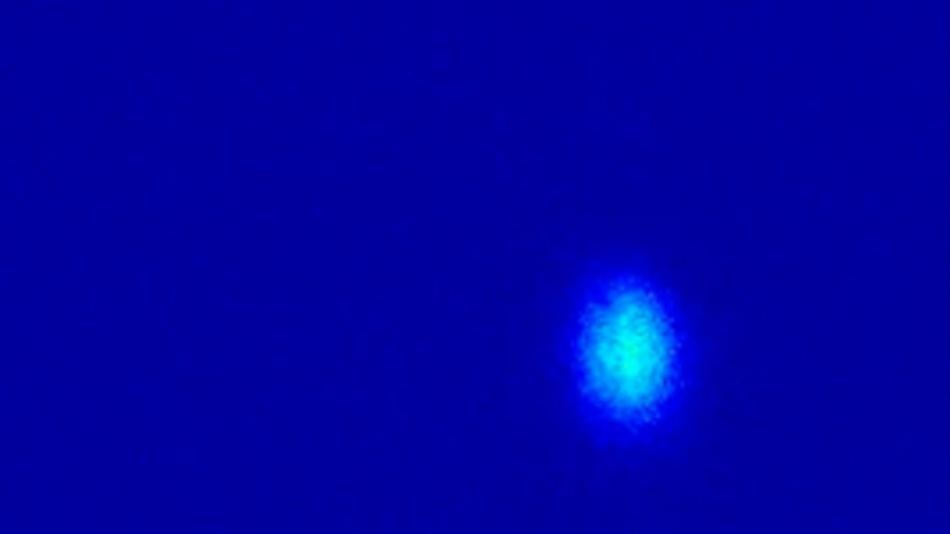May 5 2017
 This is the first Laser Light at the European XFEL, recorded by an X-ray detector at the end of the tunnel. Credit: DESY
This is the first Laser Light at the European XFEL, recorded by an X-ray detector at the end of the tunnel. Credit: DESY
In the metropolitan region of Hamburg, the biggest X-ray laser in the world, the European XFEL, has reached the last significant milestone before the official opening in September. Most of this 3.4 km long facility is located in underground tunnels and it has now generated its first X-ray laser light.
This X-ray light has a wavelength of 0.8 nm—almost 500 times shorter than that of visible light. The laser had a repetition rate of one pulse per second, at first lasing, and this rate will later increase to 27 000 per second.
This is an important moment that our partners and we have worked towards for many years. The European XFEL has generated its first X-ray laser light. The facility, to which many countries around the world contributed know-how and components, has passed its first big test with flying colours. The colleagues involved at European XFEL, DESY, and our international partners have accomplished outstanding work. This is also a great success for scientific collaboration in Europe and across the world. We can now begin to direct the X-ray flashes with special mirrors through the last tunnel section into the experiment hall, and then step by step start the commissioning of the experiment stations. I very much look forward to the start of international user operation, which is planned for September.
Prof. Robert Feidenhans’l, European XFEL Managing Director
Helmut Dosch, Chairman of the DESY Directorate, said: "The European X-ray laser has been brought to life! The first laser light produced today with the most advanced and most powerful linear accelerator in the world marks the beginning a new era of research in Europe. This worldwide unique high-tech facility was built in record time and within budget. This is an amazing success of science. I congratulate all those involved in the research, development, and construction of this facility with passion and commitment: the employees of DESY, European XFEL, and international partners. They have achieved outstanding results and demonstrated impressively what is possible in international cooperation. The European XFEL will provide us with the most detailed images of the molecular structure of new materials and drugs and novel live recordings of biochemical reactions."
When compared to standard synchrotron light sources, the X-ray laser light of the European XFEL is majorly intense and a billion times brighter. The achievable laser light wavelength corresponds to an atom’s size, highlighting the possibility of using the X-rays to make pictures and films of the nanocosmos at atomic resolution, such as biomolecules, from which improved understandings of the fundamentals of illnesses or the development of new therapies could be developed. Other opportunities cover research into catalytic techniques and chemical processes, with the aim to enhance their efficiency or make them more environmentally friendly; investigation of conditions similar to the interior of planets; or materials research.
The X-ray laser light of the European XFEL was produced from an electron beam from a superconducting linear accelerator, the vital component of the X-ray laser. The accelerator was put into operation at the end of April by the German research centre DESY, the largest shareholder of the European XFEL.
The electron pulses were strongly accelerated and prepared in a 2.1 km long accelerator tunnel for the later generation of X-ray laser light. At near-light speed and extremely high energies, the intense electron pulses entered a photon tunnel comprising of a 210 m long stretch of X-ray generating devices. Here, 17 290 permanent magnets with alternating poles interacted with the electron pulses from below and above. Undulators, or magnetic structures, bring the electrons into a “slalom” course, and extremely short-wavelength X-ray radiation is released with every turn. This radiation intensifies across the length of the undulator stretch. For the first lasing, the X-ray light, just before arriving in the underground experiment hall, was absorbed and measured.
The 3.4 km long European XFEL is considered to be the largest and most powerful of the five X-ray lasers worldwide, and it is capable of producing the short pulses of hard X-ray light. With more than 27 000 light flashes each second instead of the earlier maximum of 120 per second, the parallel operation of several experiment stations, and extremely high luminosity, it will be possible for scientists to analyze more limited samples and carry out their experiments in a much faster manner. Thus, the facility will indeed increase the amount of “beamtime” available, as the capacity at other X-ray lasers all over the world has been eclipsed by demand, and facilities have been largely overbooked.
The X-ray laser should officially open at the start of September. At that point, external users will be able to carry out experiments at the first two of the eventual six scientific instruments.